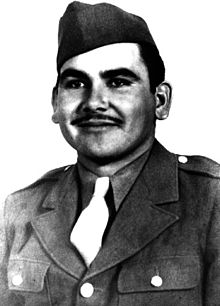Felix Z. Longoria, Jr.
| Felix Z. Longoria | |
|---|---|

Pvt. Felix Z. Longoria, Jr.
|
|
| Born | April 16, 1920 Three Rivers, Texas |
| Died | June, 1945 (aged 24–25) Philippines |
| Buried at | Arlington National Cemetery |
| Allegiance | United States of America |
| Service/branch | United States Army |
| Rank | Private |
| Battles/wars | World War II |
| Awards |
Purple Heart Combat Infantryman Badge |
Private Felix Z. Longoria (1920 – June 1945), was a Mexican-American soldier, who served in the United States Army during World War II and was buried at Arlington National Cemetery.
After being killed at war in 1945, his body was not returned to his family until 1949. Upon receiving the body, his family attempted to bury him at the local funeral home, but was denied wake services since Felix was Mexican American. The G.I. Forum fought against the injustice and he was eventually buried in Arlington National Cemetery near Washington D.C.
Born and raised in Three Rivers, Texas, Longoria later moved to Corpus Christi, TX with his wife in search of work. There his wife bore them a daughter who was only a young child when Felix enlisted. Prior to the war, he worked as a truck driver.
In November 1944, Longoria enlisted in the army and, in late April 1945, shipped out from Fort Ord, CA to the 27th Infantry Regiment of the 25th Infantry Division, then located in Luzon in the Philippines, leaving behind his wife and four-year-old daughter. He arrived on Luzon, Philippines, about June 1, 1945. Less than fifteen days after landing on the Island of Luzon, Pacific Theatre, a platoon to which Longoria was assigned was ambushed by a hidden Japanese machine gunner. Longoria was among those killed. His badly mangled remains were not identified and returned to the United States until 1949.
In Texas during the 1940s, as in other parts of the country, Mexican Americans were considered non-white.Segregation of Mexican American children in schools and employment discrimination against Mexican American workers was pervasive in the Southwestern United States. The town of Three Rivers, Texas was no exception with the section nearest the river and west of the railroad setup for Mexican Americans to live in segregation (see referenced map, the streets west of the rail lines have names in Spanish).
...
Wikipedia
